Table of Contents
Sizing is the process of separating mixed particles into groups of particles all of the same size, or into groups in which all particles range between certain definite maximum and minimum sizes. In coal preparation, sizing is generally accomplished by passing the coal over screens. Separation by differential settling in air or water currents has been adapted to the special field of separating very fine sizes, and these processes are in commercial use to a relatively small extent in the coal industry.
Preparation outside the mine started with the installation of stationary cast-iron plates with 4 to 6-in. square holes. The run-of-mine coal was dumped upon the platforms, the large pieces of rock were picked out by hand, and the large lumps of coal were broken with hammers. The term “breaker,” which still applies to the anthracite-preparation plant, originated with this practice, but the term is no longer descriptive of the entire function of the plant.
Screening Machinery
Gravity-bar Screen
The simplest kind of large-capacity screening device is the inclined stationary bar screen or grizzly. The bar screen consists of a number of equally spaced parallel bars, supported in a longitudinally inclined position so that coal delivered to the upper end will slide down over the bars.
Ordinarily, the bars are held rigidly in place by space bars, and steel side plates are provided to confine the load to the screen. Head and tail chutes are provided to facilitate delivery of coal to the upper end of the screen, and delivery of lump coal from the lower end to the loading chute or bin. A hopper is provided under the bars to receive the screening that pass between the bars and to deliver them to the car or storage bin.
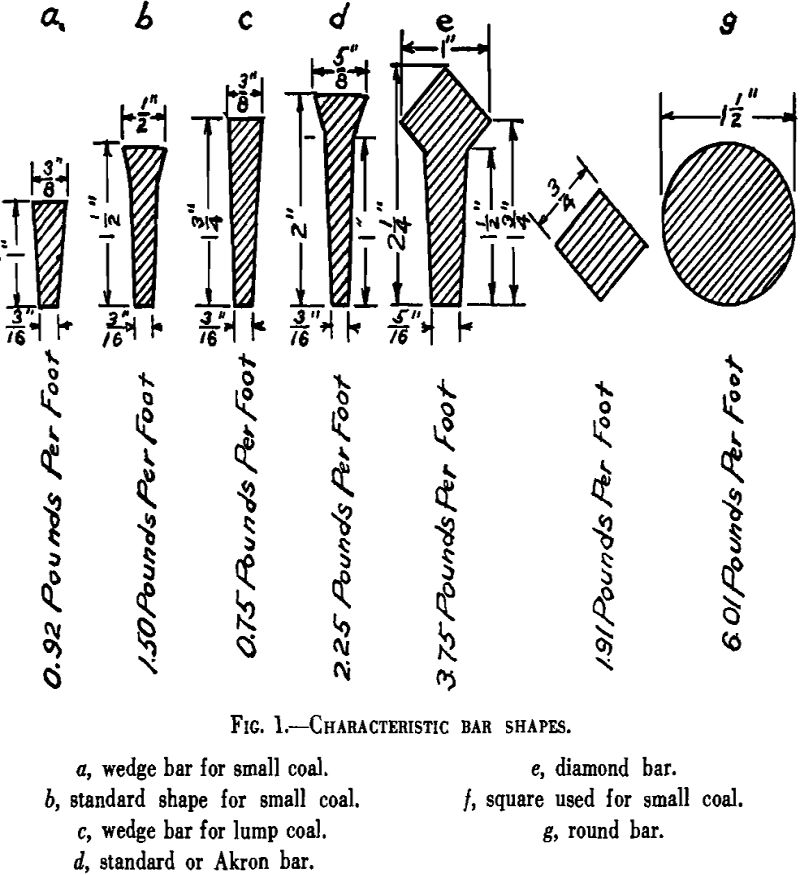
The coal that passes through this 5-in. screen then goes over the secondary screen 6½ ft. wide by 12 ft. long, set at an inclination of 32°. The bar spacing of this screen is 1 in. in the clear. The oversize 5 to 1-in. coal passes over this screen to the loading chute that delivers it to the egg, or track No. 2. The 1-in. screenings passing through the bars is collected in the slack bin for loading on track No. 3.
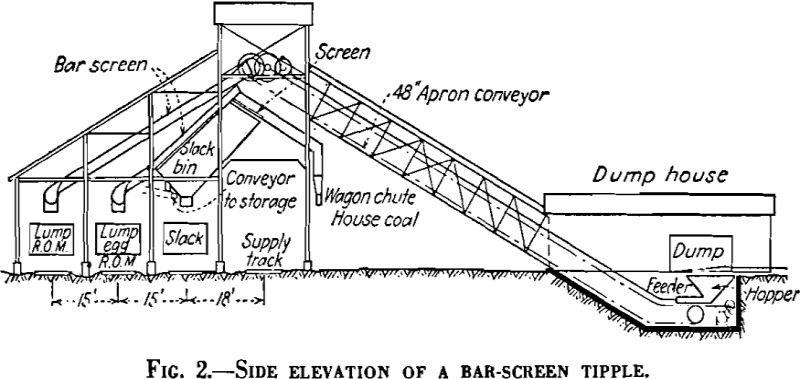
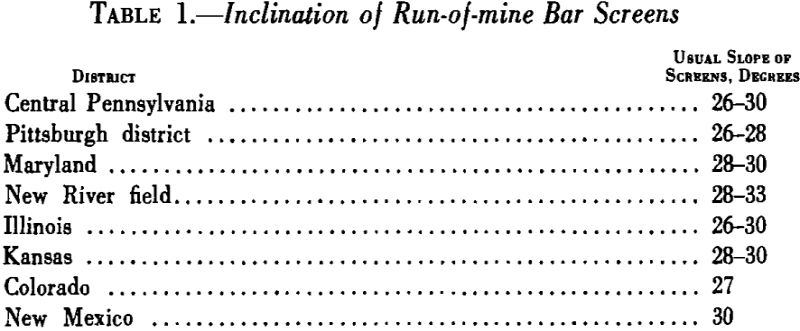
Revolving Screens
A revolving, roller, or trommel screen is a cylindrical jacket of perforated plate or wire cloth attached to the outside of cast rings or spiders and supported on a central shaft or on trunnions. Revolving screens used for coal sizing are supported usually on a central shaft set at a slight angle, so that material fed into the revolving cylinder at its higher end will travel down to the lower end and be discharged.
As the screen revolves, the particles in it are carried up the rising side until gravity overcomes both their friction against the screening surface and any centrifugal force given them by the rotation of the screen, whereupon each particle rolls or slides down until it comes to rest and then is carried up again.
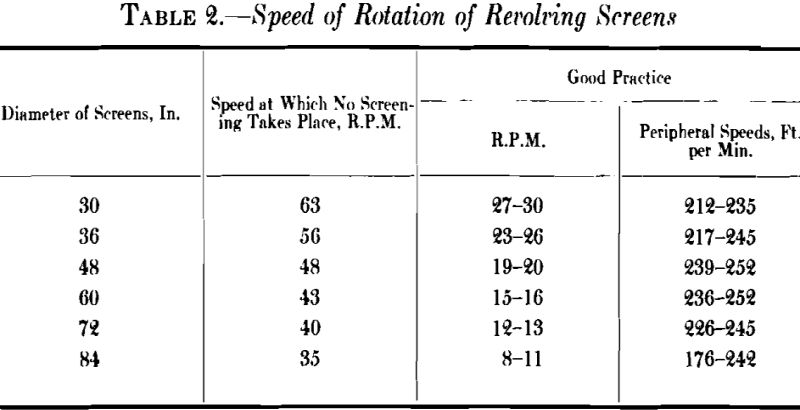
Shaker Screens
The shaker has come to be the standard screen for sizing domestic sizes of coal in both the anthracite and bituminous fields. There are two primary reasons for this: (1) the shaker screen requires less headroom than other types; (2) it conveys in a horizontal direction while screening; thus, in one operation, sizing the coal and distributing it to convenient points for loading into railway cars or for further treatment.
The factors that determine the rate of flow of material over the screen surface are: (1) the inclination, (2) the length of stroke, and (3) the speed or number of strokes per minute. A change in any one of these factors will affect the rate of travel; hence all must be adjusted to give the right combination for any given size of aperture. Large apertures require a greater conveying impulse than small apertures. Greater conveying may be obtained either by increased slope, longer stroke, or increased speed. It is evident, therefore, that several possible combinations of these three factors might give the same rate of flow but possibly not the same chances of complete screening.
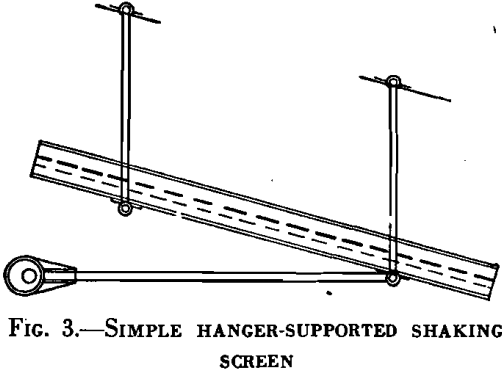
Horizontal Screens. Shaking screens with the plates supported in a substantially horizontal position have been developed to obtain the advantages of low headroom requirement. To move the feed across the screen surface in this position, it is necessary to impart special motion to the screen to give the material resting upon it an impulse in one direction.
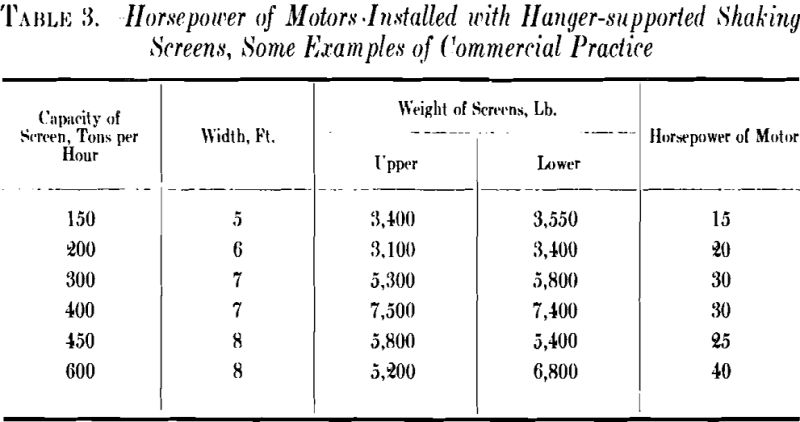

Capacity. Inspection of numerous coal-screening plants reveals wide differences in the sizes of screens used for the same capacities. The relative gross tonnages of unsized coal feed handled by two shaker screens with the same pitch, speed, and throw, and with the same thickness of coal, will be in the ratio of the screen widths. The completeness with which this run-of-mine coal is sized in passing over a screen will depend upon the length of the screening surface, as that determines the number of opportunities that each particle of undersize coal has to drop through an opening. Considered, therefore, in conjunction with an efficiency requirement—that is, the maintenance of a certain standard of precision in size separation of the coal—the capacity of a screen depends in a measure on the length as well as the width of the screening surface.
Vibrating Screens
In recent years vibrating screens have largely displaced shaking and revolving screens in ore-dressing practice. Their range of aperture extends from 10-in. to 100-mesh. They have a large capacity per unit of screen area, and low cost of operation and maintenance per ton screened. In coal-preparation practice their use has been more limited to the sizing of small coal and for dewatering fine sizes but is rapidly expanding for coarse-coal sizing and scalping ahead of primary crushers.
Construction and Operation.—Vibrating screens are operated at rather high frequency, 600 to 1800 r.p.m., with small amplitudes of vibration less than ½-in. in opposition to the large amplitudes and low frequencies of shaking screens. As in shaking screens, the movement of the particles over the screen surface is caused by gravity alone, the vibration alone, or more commonly is a resultant of both. High-frequency vibration is more effective than the slow movement of the shaker in keeping the holes clear of wedged particles and in stratifying the feed and bringing the fine particles in contact with the screen surface. Since it is difficult to vibrate uniformly a large area, vibrating screens are generally built in standard units of relatively small size as compared with shaker screens.
Anthracite Screening Practice
Pennsylvania anthracite practice is now virtually standarized on inclined shakers for sizing the domestic and upper steam sizes, with a minor trend to high-speed vibrators for dewatering and for sizing the lower steam sizes, particularly the No. 4 and No. 5 buckwheat. Even the very smallest steam sizes, however, are most commonly made over shakers. The No. 5 buckwheat is sometimes deslimed by hydraulic classification, which gets rid of most of the fines under 40-mesh.
Actual perforations used in commercial plants may vary somewhat from these but the standard of products aimed at, even in such instances, is as set forth in the specifications of standard sizes; and the inspectors test screens are of round-hole perforations of the sizes designated.
The record of breaker shipments by sizes shows a persistent long-term trend toward the smaller sizes as production comes more and more from the thinner and more friable beds and from secondary-mining operation, and progressive improvement in combustion equipment increases the use demand for smaller and cheaper steam grades.
Screens usually are hung on flexible wood hangers commonly called spring-board hangers. These hangers are secured rigidly to the screen and to the supporting structure, so that the movement of the screen will flex the hanger an equal distance on each way from its normal position.
The hangers are made of well-seasoned and specially selected hickory or ash 8 to 12 in. wide and 5/8 to 1 in. thick, depending upon the length. The shorter the hanger, the thinner it must be to obtain the necessary flexibility.
Abrasion and Corrosion
Screen surfaces are subjected to wear from abrasion and by the action of acid mine water.
Abrasion is the important cause of wear in the making of lump to pea sizes. Heavy-gauge plates would be the most economical to use from a maintenance standpoint but this has to be sacrificed in some instances because the screening efficiency is greatly affected by the thickness of the plate. There is no blinding effect due to corrosion on these 9/16-in. and larger meshes, and common steel is used for this service. It requires a life ratio of 10 to 1 in favor of stainless steel to make it economical.
All the finer-mesh screens should be supported on a frame to prevent sagging. Screens of larger mesh are sometimes used for support but it is better practice to mount a flat screen plate on a screen frame with ½-in. bar supports spaced 4 in. apart each way. A type of jacket that ensures a perfectly flat surface without sags is the perisertread screen, commonly called the step screen. The riser acts to stiffen the screen. The tread is the screening area. This type of screen has proved very successful in the screening of refuse from Chance cones, ranging from nut to barley, inclusive.
Methods of Estimating Size of Screens
No exact rules can be laid down for determining the size of a particular shaker or a series of shakers unless the proposed tonnage of run-of-mine coal to be handled can be broken down to approximately accurate tonnages of the various sizes. This is quite impossible because of changes in structure of coal and mining practices that may develop. Handling of condemned coal and varied practice in crushing of egg and stove sizes may cause concentrations of a particular size on a particular deck. All these factors have a bearing on screen area which is difficult to evaluate; experience is the best guide.
The relation between the aperture and the area is much more clearly defined than the relation between the output and the area. In a bank of four decks of shaking screens with chestnut passing over the bottom deck (equipped with ¾-in. plates) and egg passing over the top deck (equipped with 2-½-in. plates), the ratio of ¾-in. to 2½-in. is as 3 to 10, and this is approximately the ratio desired of total opening area in the two decks. However, experience indicates that for egg not more than one half the area required for chestnut is necessary. In such an arrangement, the chestnut deck obviously forms the basis for the estimate of screen area required. This must have sufficient area to handle the tonnage. The upper decks will have more than enough, as they will have the same number of segments although requiring less screen area.
The critical job of sizing is that done on the second and third decks to remove the rice and barley and to remove silt from the rice and barley. This arrangement provides adequate screen area with allowance for changes in character of feed size consist.
These screens perform one of the most severe jobs in the flow. The rate of feed must be controlled by reciprocating feeders. All run-of-mine stove and smaller screened out on the third deck of the bull shaker is fed from the storage pocket to the feed shakers. This feed arrangement and plenty of screen area provides good operating conditions.
Bituminous Screening Practice
In bituminous practice, likewise, the shaker is the most extensively used type of screen, but various others are also widely used and much coal is still shipped in the run-of-mine state. Many active mines have only run-of-mine loading plants; bar-screen tipples adapted to make lump and slack or screened run-of-mine are common in some producing areas.
Sizing Equipment
In the widely diversified bituminous coal-producing industry, the coal characteristics and the use requirements are many and varied. The preparation standards vary accordingly. For example, in the very friable high-grade coal beds of central Pennsylvania, where a large proportion of the output goes to railroad, by-product, and general industrial use, the predominant market grades are run-of-mine, screened run-of-mine, and slack, and a great many mines are equipped with run-of-mine tipples or bar-screen plants adaptable to make various grades of screened run-of-mine.
Efficiencies
Probably the most widely used efficiency number is simply the percentage removal of undersize material of the feed. To take account of any possible losses of oversize product, this may be combined with the percentage recovery of oversize. To calculate these percentages, it is necessary to make sizing tests of samples of the feed and of the screen products.
With these test data expressed in percentages, the undersize removed is calculated to the basis of total feed coal by multiplying the through product times the true undersize in the through product. This number divided by the percentage of true undersize in the feed gives the percentage removal of undersize.
Similarly, the recovery of oversize is the overproduct times the true oversize in the overproduct divided by the true oversize in the feed. True undersize and true oversize in each instance means the percentage determined by screen test which should be made in accordance with the standards 5 prescribed by the American Society for Testing Materials.
These are very simple computations. They may be set up algebraically as follows:
Let
O = percentage of feed that passed over screen (in operation).
U = percentage of feed that passed through screen (in operation).
Of = percentage of true oversize in feed (by screen analysis).
Uf = percentage true undersize in feed (by screen analysis).
Oo = percentage true oversize in overproduct.
Uo = percentage true undersize in overproduct.
Ou = percentage true oversize in underproduct.
Uu = percentage true undersize in underproduct.

Efficiency sometimes is taken as the first of these two expressions and sometimes as the product of the two. Such efficiency numbers are of value as qualifying factors in screen-capacity ratings, for a capacity figure obviously is of little significance unless the other performance factors are specified
However, the efficiency numbers should be supported by all other data available on the performance of the screen and the physical conditions of operation, in order that an intelligent appraisal of any given screening operation may be made.
The misleading element in all efficiency numbers of the percentage type is the predominant effect of the size of the base factor (in this instance, the true undersize in the feed). An effective screen operation should remove all but a limiting residual proportion of the undersize from the overproduct, almost regardless of the amount of fines in the original feed. Hence, the comparison of percentage efficiency numbers for a screen operation on a feed coal that is half undersize compared with one that contained 10 per cent undersize, for example, is likely to reflect the large difference in size consists of the two feeds instead of the difference in actual screening efficiency.
Relation of Size Consist of Feed to Screen Performance
In the size consist of the feed to a screen, the controlling element is the proportion of particles that are so near the size of the holes that it is difficult to get them through the screen.
The process of removing undersize material through a screen may properly be considered in two steps: first, the undersize material must pass down through the oversize bed to come in contact with the screen surface; second, the undersize particles must pass through the screen apertures. Both of these functions obviously are facilitated by suitably adjusted screen motion—sufficient to open the oversize bed and to keep the screen cloth free from blinding.
Rapid penetration of fines to the screen surface is hampered by excessive thickness of the oversize bed on the screen and by high surface moisture. The rate of extraction of undersize through the screen aperture likewise will be retarded by high surface moisture in the feed and also by the presence of a layer of near-mesh particles on the screen.
Relation of Surface Moisture to Screen Performance
Surface moisture causes difficult problems in maintaining effective screen performance and high standards of preparation of market grades of coal. In fact, wet small coal of such a consistency that the particles stick together en masse cannot be screened in that condition. However, some information has been collected that assists in estimating the performance on damp and wet coals, and certain aids have been devised to improve performance with undesirable moisture. The effect of moisture varies greatly according to other related conditions, such as the following: (1) size at which separation is to be made; (2) frequency and time length of wet coal runs; (3) wet coal and high proportion of fines; (4) wet coal and peak loads; (5) wet coal and high proportion of clay and shale mud.
The effect of minor wet-coal conditions, up to the point where complete blinding of the screen medium occurs, is to increase the proportion of undersize and slack in the over-product. This effect may be attributed to two major causes: (1) sluggish movement of the coal load and hampered intermovement of particles that prevent some of the undersize from getting down to and passing through the screen, and (2) adherence of a coating slack on the coarse pieces that go into the oversize.
A vibrating screen clothed with ¼-in. Ton-Cap screen (apertures ¼- in. wide by ½ in. long) will operate satisfactorily on coal containing up to 5 per cent mechanical moisture content. This feed, however, will blind a cloth of 1/8-in. mesh and will give some trouble on 3/16-in. Six per cent moisture will not cause the ¼-in. cloth to blind but will greatly reduce the effectiveness of the screens. Table 21 gives approximately the effect of moisture content in the feed on the effectiveness of screens. These figures apply to the use of the standard type of oblong mesh cloth on vibrating screens. Sizes refer to net width of opening. Percentages of moisture indicate mechanically held moisture above the natural bed moisture. The data are based upon experience with Pittsburgh coal of about 1.2 per cent coal-bed moisture. The efficiency figures express the percentage removal of available undersize material present in the unsized coal when the screen is fed at the rate that will give 95 per cent effectiveness with dry coal—initial condition shown in first line, 2 per cent moisture.
Effect of Overloading on Size Consist of Products
Both wet coal and overloading have direct effects upon the sizing effect of the screen operation, which may be described as: (1) reducing the effective mean size at which separation actually is made, and (2) making the size separation less precise. Both these effects increase with the seriousness of the condition up to the limiting condition where wet coal or overload, or both together, completely block the screen.
In any practical screen operation there is a substantial difference between the effective separation actually obtained and the exact size of the holes. This is due largely to incomplete removal of near-mesh particles.
The bulk of the 2-in. and 1-in. grade actually ranging between 1½ and ½ in. in actual particle size represents presumably an aggravated case of overloading, although probably not rare in commercial practice. The condition may be corrected and the actual size consist brought more nearly into line with the nominal size designated by lightening the feed to the screen or by increasing the size of screen holes so as to shift the bulk of the curve over into the range between 2 in. and 1 in. This expedient of using larger holes than the product size specification calls for is frequently adopted to obtain an approximately sized grade with a high capacity. When carried too far it results in a very unprecise job of sizing. The method may also be used to compensate for difficulties arising from wet coal and heavy peak loads. The same problems may also be met in a measure by the use of oblong holes and special screen mediums.

